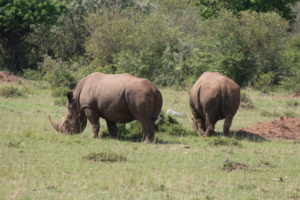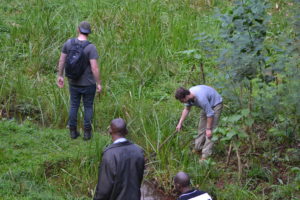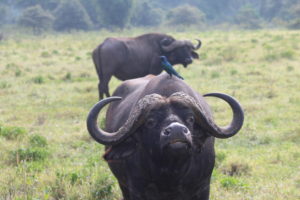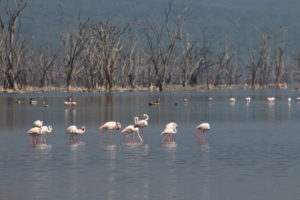After saying farewell to our French amis, we left the Maasai Mara. The many rocky roads (not the kind with marshmallows unfortunately) that lay ahead were no challenge for the TVTC (the van that can), a 1.8L, two wheel drive, monster of a van that could cross rivers, climb hills and probably scale mountains – all with up to nine people in it.

On the journey we were fortunate enough to see the last two White Rhino left in the Maasai Mara region, accompanied by their 24/7 security team – an armed squadron that would have looked more suitable guarding some of Kenya’s elite politicians than these two horny beasts. Our incredibly fortuitous encounter * attributed to the Jamaican charm of Andrea and the lucky rock I had picked up back in Nairobi. Tongue out of cheek though, it’s very unfortunate that illegal poaching has affected their population so dramatically, the work and dedication of rangers to restore the species was impressive.
*: The maasai mara region is over 1,500 km2 in size and these rhinos were about 50m from the road we happened to be driving on.

Many hours of disc-slipping, teeth-chattering driving later we made a stop for van to be repaired. Despite the expert manoeuvring of our driver Isaac, the front bumper had come loose and had to be welded back on. This did, however, give us a chance to explore the local area we had stopped in. It seemed that with each step another local child joined our sides and followed us around, kindly greeting us all as Wmzungus (Swahili for White people). After a bit of exploring we came across what, to the layman, may have just seemed like a roadside puddle filled with pollution, silt, livestock waste, algae and maybe even some water. However, it was in fact, a roadside puddle filled with frogs (as well as all of the above). Of course Tom “Frogman” Jameson couldn’t let the opportunity pass, and so got stuck in, trying to catch one of his amphibious friends. However, the nimble frogs evaded his capture and tactics had to be changed. Luckily, we had amassed quite a following by this point, around ten children and four moped drivers that had pulled over to watch – probably questioning what these crazy Wmzungus were doing elbow deep in filth. Enoch managed to recruit one of the moped drivers to buy us a net and another to fetch a shovel. So within mere minutes we were fully equipped to catch, arguably the most dangerous ** of all species we had encountered so far.
**: frogs reside in murky water, either in the form of crocodile infested rivers or cholera rich puddles – so this statement is not as ungrounded as it may seem.
With a trench dug to drain a little of the water and the net placed across, we managed to catch two frogs, one of which jumped out of the net, the other required bagging into a ziplock bag for identification. Tom, the encyclopaedia that he is, identified it as the Lake Victoria clawed frog (Xenopus victoriana). The van was fixed, frog released and we were back on the road to Kericho.
When we arrived, we were greeted by a plantation manager, who also happened to be Enoch’s cousin. Enoch, our guide, seems to have a relative in every town, in every profession across the whole of Kenya. We were taken on a private tour of Kericho’s Rainforest Alliance (RFA) certified*** tea plantations and given an overview into the tea growing business. Tea is Kenya’s biggest export, the potential damage from fertiliser and insecticide over use, as well the deforestation associated with plantation creation, is of particular concern for conservation. RFA policies ensure fertiliser use is limited, damage on surrounding biodiversity is minimised, as well as protecting living and working standards for employees (to name a few). In the process we managed to, once again, gather quite the crowd; a whole class of school children followed us to the plantation to watch from the road.
***: Ever bought tea with a little frog logo on the front? Well keep going, we approve.

After the plantation we were taken to the factory. In true field scientist fashion, we the donned some lab coats. After the obligatory hand and shoe sanitations, we were taken around to see how our English beverage of choice was dried, shredded, sieved and packaged before being sent around the world.


The following day, we were given a tour of the local area’s swamps by the very helpful manager from our accommodation. Using the wire mesh from the day before, machete chopped branches and some barbed wire, Frog net v2.0 was born – now with a handle, and a deeper net (buy yours today – frogs not inc.). With several more frogs (Angolan river frogs) and tadpoles bagged, Tom’s insatiable amphibious appetite quelled for the day; we got back on the road heading for Nakuru.

With a hotel in the city for one night, we were given both a political and musical education over dinner in true Kenyan style – through the TV’s political propaganda and gospel music channels. The following day we arose early to visit Lake Nakuru National Park (NP). This park is distinct from those visited previously. The Maasai Mara NP is under Country council management, has no boarders and is continuous with the Serengeti national park in Tanzania – combined forming a highly wild ecosystem of over 16,000 km2. Nairobi NP is managed under KWS (Kenyan Wild Life Service – a central government agency) and has only partly fenced boarders – the open wildlife corridors that surround were the sites of our camera trap investigation. Lake Nakuru NP was also under KWS management and has fully closed boarders, a response made to increasing urbanisation pressures. The park provides a case study of a mature NP and hence gives useful predictions for potential future of Nairobi – of particular use to us given our study.
Lake Nakuru was a stunningly beautiful area, with a vastly different biome to the previous parks we visited. When we first arrived the luscious green rolling hills were peppered with herds of buffalo, all hidden behind a veil of mist that hung in the air. Attempts to call the herds closer with mediocre cow mooing impressions were unsuccessful, achieving little more than angry grunts and stares from the larger bulls. By midday, the air was clear and the central lake was filled with migrating flamingos – their flamboyant pink bodies a stark contrast to the drowned forest that surrounded the lake. We also saw our first two male lions, these ferocious felines were found sleeping under a tree – obviously hunting wasn’t on the agenda for that afternoon.



We navigated back through the winding roads of the park and payed our protection money to the baboon gangs that ran the exit ****, we left heading for our hilltop huts overlooking the lake.
****: Well obviously not money, baboons don’t have pockets. They will steal just about everything from your van if you leave a window or door open though. As proven by the fights between alphas over bags of bread and shopping bags filled with fruit.

Upon arrival, we were all very happy with our accommodation near Lake Naivasha: sunny weather, hilltop views over the lake, wooden huts and outdoor fire pits. It was the ideal stop over point on our South West tour of Kenya. We split up, collecting firewood and setting up our rooms for the night. Things took a slight turn for the worse when the monsoon began. A tropical thunder storm orchestrated by bolts of lightning over the lake. Suddenly our huts seemed less attractive, their corrugated iron roofs and open air design, with gaps between the planks and no windows (holes for windows just nothing in them) proved to be slightly problematic. After some impromptu duct tape DIY our airy huts were slightly less so and our patchwork mosquito nets had been repaired. We spent almost an hour sitting under cover just watching the storm, taking in its slightly terrifying beauty.
We spent the rest of the evening at a pretty surreal bar by the lake. Meeting some other fellow Wmzungus for the first time and taking in the bar’s fine euro-pop music selection. The chilled out sexy vibe intermittently disturbed by someone shouting “hippo”, which passed by the electric fence that surrounded the bar.
After dinner we headed back to our rooms, and passed out for about 12 hours. Reflecting what had been an eventful, yet undeniably special, three days.
Charlie Jordan
